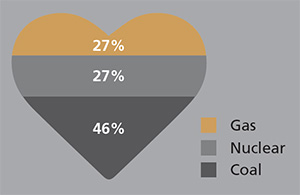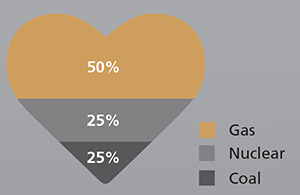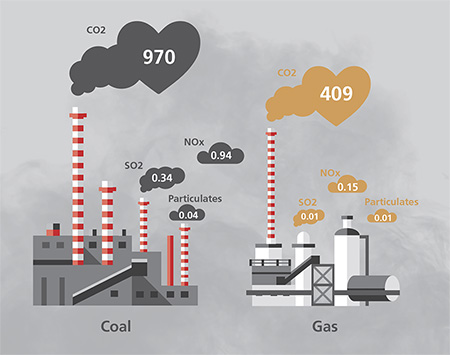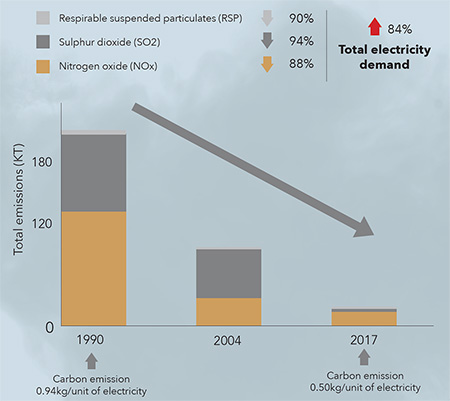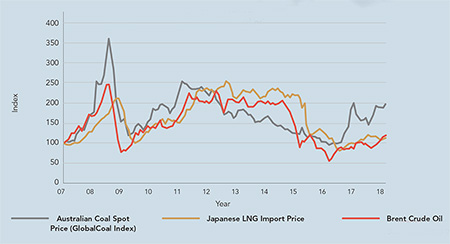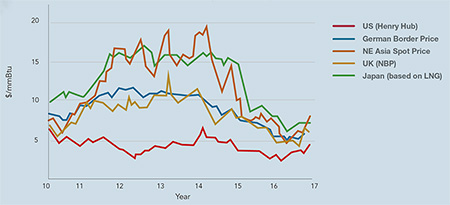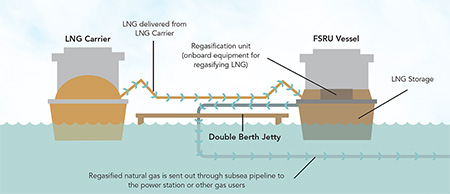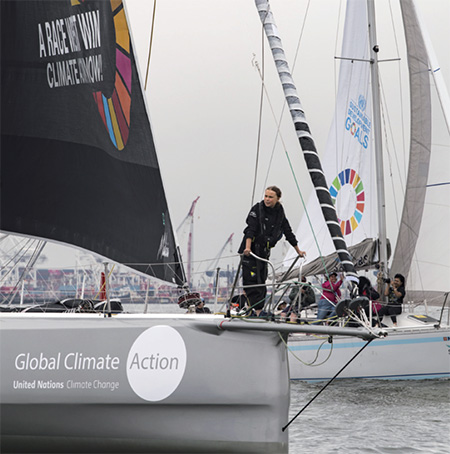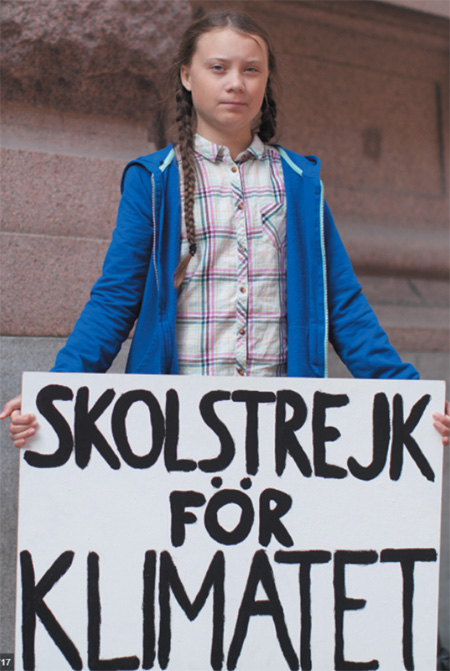Dr William Chung, Associate Professor in the Department of
Management Sciences, argues that access to cheaper Liquefied
Natural Gas (LNG) world markets can allow Hong Kong to
enjoy a coal-free, nuclear-free future. The key to net zero
carbon emissions by 2050 is carbon offsetting and this creates
an opportunity to green the Belt and Road.
Climate change is the
defining issue of our time
and we are at a defining
moment. The United Nations
has declared that "rapid and farreaching"
changes are required in
order to keep the global average
temperature rise below 1.5°C
relative to pre-industrial levels. A
special report released by the UN
Intergovernmental Panel on Climate
Change in October 2018 set an
urgent new goal: net zero carbon
emissions by around 20501. This
article shows how Hong Kong can
achieve this emissions target by
relying primarily on LNG, and using
carbon offsets to create a win-win
situation and green the Belt and
Road.
The Hong Kong government is
making its contribution. A public
engagement document "Longterm
Decarbonisation Strategy"
was issued through the Council for Sustainable Development of the
Environment Bureau in June 2019.
It seeks to "provide a platform to
gauge the views of the community
in formulating Hong Kong's longterm
decarbonisation strategy,
charting practical pathways and
developing feasible actions to
achieve net zero carbon emission
by 2050."
Meeting this target is certainly a big
challenge. Around 67% of Hong
Kong's carbon emissions come from
the power sector and around 50%
of electricity is generated by coalfired
power plants which incur the
highest carbon intensity. So, the
power sector is critical.
The Hong Kong energy mix in 2017
The Hong Kong energy mix target for 2020
Curbing air pollution and
carbon emissions (2014-2020)
The Hong Kong government first
targeted air pollution reduction by
means of using relative "cleaner"
natural gas in electricity generation.
Then, carbon emissions reduction
became the major target for
combating climate change (Climate
Action Plan 2030+).
| Hong Kong plans 80% nuclear and renewables by 2050 |
|---|
|
To achieve a carbon reduction target of well below 2°C in 2050 that
is in compliance with the Paris Agreement, it is estimated that about
80% of our electricity would need to come from zero carbon energy sources (including renewable energy and imported nuclear energy).
As Hong Kong has very limited renewable energy potential, regional
cooperation plays a crucial role in helping us achieve a higher carbon
reduction target beyond 2030.
Public Engagement Document, June 2019
|
The limits of coal-fired
generation
Hong Kong's electricity sector
has always been privately-owned
and operated, and is run by
two vertically-integrated power
companies, Hong Kong Electric
(HKE) and China Light and Power
(CLP). HKE provides about onequarter
of the territory's power
to Hong Kong Island and Lamma
Island, whilst CLP provides around
three-quarters of the total to the
New Territories, Kowloon and
most of the outlying islands. The
two companies are regulated
under a Scheme of Control (SoC)
Agreement with the government which is periodically renewed.
Back in 1997, the Hong Kong
Government decided not to build
any new coal-fired power plants.
The idea was to reduce particulate
matter, SO2 and NOx, and to
resolve the air pollution problem.
Any retired coal-fired power plants
were to be replaced by natural gasfired
power plants. This strategy
was based on natural gas being
considered a kind of relatively
"clean" energy, and has seen
dramatically improved pollution
performance at CLP.
In order to meet the targets set in
2014 and 2017, Hong Kong began
to replace coal-fired power plants
with gas-fired. The generation
capacity of the two power
companies in 2018 is summarised
by fuel type in the table on the
facing page.
There were ten gas-fired power
plants satisfying 27% of electricity
requirements in 2017. SO2 and
NOx have been greatly reduced
at CLP, which supplies around
77% of Hong Kong's electricity
requirements.
Progressive reduction of emission target (base year 2005)
Emissions from CLP generation units in 2018 (g/kWh)
Generation capacities of Hong Kong power companies
* Source: https://www.clp.com.hk/en/community-and-environment/green-tools/energy-costs (May 2019)
In this replacement process, Hong
Kong faces two major challenges.
First challenge – increased fuel costs
The fuel for electricity generation is
imported and the fuel cost factor
of a gas-fired unit is around three times that of a coal-fired unit.
Consequently, using more natural
gas means that the electricity tariff
will increase sharply. Hong Kong is
facing significantly higher costs to
curb air pollution. Added to that,
fuel prices are volatile as shown in
the index below.
CLP total emissions 1990-2017
Source: CLP (2018)
Second challenge – diversification of LNG fuel
sources
CLP has two main gas supply
sources, the Yacheng Gas Field near
Hainan Island, China which has
been used since 1996 and is nearly
exhausted, and the Second West-
East Gas Pipeline (WEPII) which
came on stream in 2013. This is the world's longest gas pipeline
crossing 14 provinces of China.
HKE, on the other hand, has
a steady supply of LNG from
Australia's North-West Shelf and Qatar. The LNG is shipped to
Shenzhen where LNG is gasified
and delivered to HKE by pipeline2.
When CLP's Yacheng Gas Field is
exhausted, it will rely on a sole LNG supplier. This is not good
business practice, especially given
the increasing role of gas-fired
generation in the Hong Kong mix.
This vulnerability of supply was
highlighted when CLP encountered
a two-month suspension of gas
supplies from WEPII due to a
landslide in Shenzhen in December
2015. As a result, CLP needed to
use more coal-fired power plants
and this affected its air pollution
performance. So, the diversification
of gas sources is an important issue.
Fuel price index of CLP
Source: CLP (2018)
A global LNG market
To resolve the challenges of gas
price stability and supply security,
the two power companies have
proposed to build an offshore LNG
terminal. This uses state-of-theart
Floating Storage Regasification
Units (FSRU) to enable direct
purchase of LNG from the
international gas market.
| A global LNG market |
|---|
|
The natural gas market is becoming more globalised, and is rapidly
changing as can be seen in the divergent prices of natural gas in 2011-
2016. For example, in 2012, the spread between NE Asia average spot
price at around US$15 and UK average price was about US$5/mmBtu.
To investors, such kind of price divergence was extremely important
because it is closely monitored by spot suppliers of liquid natural gas. In
order to maximise these suppliers’ profit, they would look to ship their
liquid cargoes to the most profitable destinations, typically NE Asia and
Japan.
The convergence of natural gas prices will speed up with the maturity of
trading hubs and the increasing capacities of LNG's production facilities
and cargoes. Since 2016, average gas prices in NE Asia and Japan have
been around US$6/mmBtu, while US prices were around $3.5/mmBtu,
illustrating the relatively narrow global price range. Obviously, there
must be a price gap between US and Asia due to the varying shipping
costs.
Price convergence has caused two significant changes in the gas market:
shorter contract periods and the delinking of gas and crude oil contract
prices. According to the International Gas Union, there is a gradual shift
from long-term (5+ years), fixed destination contracts to short-term (less
than 2 years) and medium-term ones (2-5 years), due to an increase in
the number of contracts that have the flexible destination option and also
due to the emergence of new producers and consumers. For contract
prices, historically, natural gas prices have been indexed to the price of
crude oil and therefore most gas contracts use an oil price as the main
index. Recently however, natural gas prices have been increasingly
delinked from crude prices, with the potential to get much cheaper.
|
Convergence of LNG prices
Source: https://www.igu.org/resources-data
Floating Storage Regasification Units
Source: CLP (2018)
An understandable concern for
Hong Kong residents is if there is access to an international
gas market right now, why is
there a need to build this new
infrastructure? This is because the
profit of power companies in Hong
Kong is determined by the Scheme
of Control Agreements3,4 with the
government. Profit is equal to the
permitted rate of return for each
year and this is capped at 8% of
the total value of their Average Net
Fixed Assets for that year. That is,
the profit of the power companies
relies upon how many fixed
assets the companies have built.
Consequently, the power companies
are constantly interested in
investing in more fixed assets, such
as the FSRU, in order to generate
more profit. The effectiveness of
FSRU in terms of gas price stability
and supply security is not the key
concern of the power companies.
Hence, we should take a look at the
development of the LNG market
and check if using an offshore LNG
terminal is effective in the near
future. We conclude, as long as the
LNG's prices are globally converging and the infrastructure of the LNG's
market is becoming mature, the
effectiveness of FSRU is justified.
How Hong Kong can meet net zero carbon emissions by 2050
While Hong Kong had been
putting some effort into curbing
air pollution and reducing
carbon emissions, an urgent and
challenging target emerged:
achieving net zero carbon emissions
by 20505. To achieve this carbon
neutral state, various international
cities and countries have set
strategies such as6:
- Enhancing education and public awareness to reduce
consumption
- Enhancing building energy efficiency – for example, energy saving works (e.g. retrofitting and retro-commissioning) mandatory for all existing large buildings, and mandating all new buildings to be net zero carbon emissions
- Promoting green transport – such as mandatory zero emission vehicles to replace all conventional fuel-driven vehicles
- Deep decarbonisation in the energy (power) sector – such as using renewable energy and nuclear energy as the major energy sources, supplemented by fossil fuel generation equipped with carbon capture and storage technology
- Technological breakthroughs – rigorous technological breakthroughs and advancements to reduce and offset carbon emissions
Indeed, decarbonisation in the
energy sector is the most critical
pathway. Enhancing building
energy efficiency alone cannot
achieve a net zero target although
90% of electricity consumption is
from buildings. Promoting green
transport implies accelerating
the adoption of electric vehicles,
which pushes the emissions back
to the power plants. Hence,
not surprisingly, the Hong Kong government proposes to use
nuclear and renewable generation
(solar and/ or wind) as the
major energy sources. Nuclear
and renewable generation are
generally considered as having a
"virtual" zero carbon emission.
However, even nuclear energy
and photovoltaics have a certain
amount of lifecycle green house
gas emissions compared to other
renewables. But, other concerns
may negatively affect Hong Kong in
the adoption in achieving the zeroemission
target.
Fukushima and worldwide opposition to nuclear power
The increased use of nuclear
energy, may be constrained by
public concerns. The nuclear energy
currently imported from mainland
China contributes around 25% of
Hong Kong's electricity supply. In the
2014 consultation document (Future
Fuel Mix for Electricity Generation),
the government proposed to import
more nuclear from mainland China,
but met with societal concerns due
to the 2011 Fukushima incident.
Indeed, if we look internationally,
four regions have undertaken to
end nuclear power generation
completely – Germany, Switzerland,
Belgium and Taiwan.
How about renewables? Land
scarcity does not allow Hong
Kong to deploy large-scale solar
or wind farms, and offshore busy
sea lanes ensure that wind farms
are impossible. In June 2019, the
Hong Kong government published
Public Engagement on Long-term
Decarbonisation Strategy7, where
it is estimated that according to
current technologies, there are
only modest realisable renewables
including solar, wind, and wasteto-
energy at about 3%-4% of total
demand, by 2030. The government
therefore proposes regional
cooperation allowing Hong Kong
to tap into renewables available in
mainland China.
Note that the government also
considers that importing more
nuclear energy from mainland
China is a kind of regional
cooperation. The existing
connecting grid is being enhanced
to supply around 30%-35% of
Hong Kong's fuel mix.
A carbon neutrality coalition
The effectiveness of regional
energy cooperation around the
world is well documented in
the government's consultation
publication. For instance, there
are interconnective grids between Norway, Sweden and Germany
allowing Denmark to export
excessive wind power when
necessary, and to import Norwegian
hydropower, Swedish nuclear
power and German solar power
when the wind is still.
Obviously, this kind of regional
cooperation is not comparable to
that proposed by the Hong Kong
Government in the engagement
document, in which Hong Kong
invests in nuclear and renewable
generation capacity in mainland
China and transmits the power to
Hong Kong. In terms of energy
policy, it is not a good practice,
as mainland China also requires
green generation to meet the net
zero emission target. Although the
government's energy policies have
considered the criteria of reliability,
security and availability, and
affordability, the more appropriate
energy policies should include the
consideration of "equity". That is,
we need to consider if Hong Kong's
energy policies negatively affect the
"reliability, security and availability,
and affordability" of mainland
China's power market. Currently,
the more power is imported from
mainland China to Hong Kong, the
more unreliability is imposed on
China's power system and end users.
Moreover, if the government
insists on the proposed regional
cooperation, it should be aware
that the technologies of power
systems are enhancing rapidly, for
example in intelligent grid systems
and ways to store electricity, such as
giant battery plants. It is therefore
recommended that such kind of
cooperation should be revised every
five years to meet the 2050 target.
Instead of considering regional
cooperation through importing
predominantly nuclear generation
capacity, we should explore other
viable alternatives, such as a carbon
neutrality coalition.
The importance of planting trees
Although land scarcity prevents
Hong Kong from implementing a
carbon sink strategy locally, we may
still consider the path of carbon
neutrality8 by means of planting of
trees in the Belt and Road countries and mainland China thereby
obtaining a carbon credit to offset
Hong Kong's carbon emissions9.
Indeed, mainland China can initiate
a Carbon Neutrality Coalition10
for Belt and Road countries.
With Hong Kong's investment in
offsetting carbon emissions, China
could develop a Green Belt and
Road. Note that reducing emissions
from deforestation and forest
degradation in developing countries
is also a kind of carbon neutrality11.
IPCC12 presents a research output
that the carbon neutrality potential
is estimated up to 23 GtCO2
dominated by reduced rates
of deforestation, reforestation
and forest management, and
concentrated in tropical regions.
A green future
Assuming that Hong Kong uses
gas-fired power plants to supply the
63,000 million kWh consumption
requirement in 2050 (this implying
around 1% increase annually), with the current emission factor
(488gCO2eq/ kWh), Hong Kong
needs to offset 30.8 million tonnes
CO2e which would require planting
around 52 times Hong Kong's land
area13. According to Pakistan's
cost factor14, current marginal
abatement cost (US$/tCO2e
reduced) is around $10 to $25.
The estimated offsetting cost for
Hong Kong from now until 2050 would be around US$308 million
to US$770 million at current US$
prices in total. With 68 Belt and
Road countries to plant trees in,
there is plenty of scope for Hong
Kong to start the carbon neutral
process now and meet the future
net zero emission target by 2050.
Assuredly, this kind of "regional
cooperation" would result in a winwin
situation.
Greta Thunberg, the 16-year-old climate activist from Sweden, sails into New York Harbour flanked by a fleet of 17 sailboats representing each of the United Nations Sustainable Development Goals on their sails
Courtesy of the UN Photo by Mark Garten
How about Hong Kong?
How should we generate power?
Gas, nuclear, renewables?
What do you think?
"Changing one disastrous
energy source for ‘a
slightly less disastrous
one’ is not progress"
Greta Thunberg climate activist
| Carbon sinks |
|---|
|
Carbon sinks are natural systems that soak up and store CO2 from the
atmosphere. Forests are great examples. During photosynthesis, trees
and plants sequester or absorb CO2 from the atmosphere, using it as
food for growth. The carbon from the CO2 becomes part of the plant
and is stored as wood, stems and leaves. Although forests do release
some CO2 in their natural succession, a healthy forest typically stores
carbon at a greater rate than it releases carbon.
The existing carbon sink in Hong Kong is only about 1% of the
total carbon emissions, hence the importance of a regional carbon
neutrality policy.
Public Engagement on Long-term
Decarbonisation Strategy, 2019
|
| What are carbon offsets? |
|---|
|
A carbon offset is a reduction in emissions of carbon dioxide or
other greenhouse gases made in order to compensate for emissions
made elsewhere. Offsets are measured in tonnes of carbon dioxideequivalent
(CO2e). One tonne of carbon offset represents the
reduction of one tonne of carbon dioxide or its equivalent in other
greenhouse gases.
Offsets typically support projects that reduce the emission of
greenhouse gases in the short or long-term. Common project types
are renewable energy, energy efficiency and forestry projects.
|
| The potential for global forest cover |
|---|
|
The restoration of forested land at a global scale could help capture
atmospheric carbon and mitigate climate change. Bastin et al. used
direct measurements of forest cover to generate a model of forest
restoration potential across the globe. Their spatially explicit maps
show how much additional tree cover could exist outside of existing
forests and agricultural and urban land. Ecosystems could support
an additional 0.9 billion hectares of continuous forest. This would
represent a greater than 25% increase in forested area, including more
than 500 billion trees and more than 200 gigatonnes of additional
carbon at maturity. Such a change has the potential to cut the
atmospheric carbon pool by about 25%.
Science, July 2019
|
References:

Dr William Chung
Associate Professor
Department of Management Sciences
